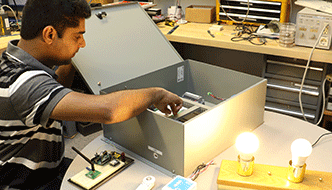
Doctoral student Dinusha Thotagamuwa presented his initial research toward developing effective, real-time monitoring of system performance and estimating the remaining useful life of an LED lighting system.
Two doctoral students and several research scientists from the Lighting Research Center (LRC) at Rensselaer attended the recent SPIE Optics + Photonics conference to present research on new innovative technologies and other topics of interest to the solid-state lighting industry. The presentations were part of the Fifteenth International Conference on Solid State Lighting and LED-based Illumination Systems, which took place Aug. 31 in San Diego, California.
As part of her doctoral research, Ph.D. student Xi “Molly” Mou has been investigating optical and lighting properties of area-type light sources, including OLED and edge-lit LED technologies, to define technology and human factors requirements. In her study, “Evaluation of OLED and edge-lit LED lighting panels,” Mou explored how the brightness and discomfort glare of these two lighting panels were perceived by human subjects. Her study results revealed no statistically significant difference in subject responses to discomfort glare between OLED and edge-lit LED panels when the two panels produced the same lighting stimulus. In other words, both technologies appeared equally glary beyond a certain luminance.
Mou’s research adviser and LRC Director of Research Nadarajah Narendran said that one of their goals is to develop a scientific metric that can be used to accurately predict the human perception of lighting quality, specifically the lighting uniformity of a large-area lighting panel in this case and its perceptual glare rating. “This research would allow for more efficient, glare-free area light sources to be built with uniform appearance and desired light output for the application’s needs, while adding knowledge to the topic of human visual perception,” he said.
Doctoral student Dinusha Thotagamuwa presented his initial research toward developing effective, real-time monitoring of system performance and estimating the remaining useful life of an LED lighting system. In his presentation, “Remote monitoring of LED lighting system performance,” Thotagamuwa described his investigations into the parameters and data-driven methods that can signal the impending failure of an LED lighting system and predict the remaining time until failure. His preliminary study showed that the Euclidean distance method can be useful to predict failure time accurately.
Narendran noted that with the expected future growth of the Internet of Things (IoT) and connected lighting systems for intelligent buildings, an understanding of lighting system failure will be key. “Remote monitoring of lighting system performance will be a welcome feature for building managers who want to optimize energy usage by controlling lights and schedule timely maintenance of fixtures ahead of failure,” he said. In conjunction with the failure prediction research, the LRC is conducting ongoing IoT-related research in the areas of communications protocols and wireless data transfer as part of the larger study of remote monitoring systems for LED lighting.
Three additional presentations were given by LRC researchers: “A spectral measurement method for determining white OLED average junction temperatures,” by LRC Research Scientist Yiting Zhu; “Measuring the temperature of high-luminous exitance surfaces with infrared thermography in LED applications,” by LRC Research Scientist Indika Perera; and “Projecting LED product life based on application,” by Narendran.
The papers have been published in the SPIE conference proceedings and are available from the LRC website.


